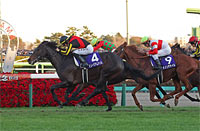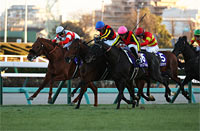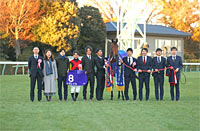Arima Kinen (The Grand Prix) (G1) - Data Analysis
Note: “1-win,” “2-win,” and “3-win” classes correspond to the previous “5 million yen-or-less,” “10 million yen-or-less,” and “16 million yen-or-less” classes.
Which runner will dominate the year-end grand prix?
The Arima Kinen (The Grand Prix) will be held immediately after the Hopeful Stakes this year, marking the grand finale of the JRA racing program. While the COVID-19 pandemic has affected races in 2020 (primarily in the form of restricted entry to racecourses and WINS facilities), this year has also brought exciting developments such as the emergence of two undefeated triple crown winners and Almond Eye winning her ninth G1 race. The question on everyone’s mind at present is which runner will dominate the curtain closer of the year. Let’s now analyze the data for the last 10 years.
Runners starting in inner brackets essentially have an edge, especially in races with a moderate pace
Runners in the Arima Kinen need to pass six corners, so those starting in the inner brackets have an edge (because they are less susceptible to a distance disadvantage), and those starting in the outer brackets are more likely to struggle. For example, runners starting in Bracket 8 have only produced one Top 3 finisher over the last 10 years. Runners starting in the inner brackets tend to perform particularly well in races where the overall pace is slower. Looking at races with a relatively moderate pace, we find that the top places were occupied (in descending order) by the runners starting in Brackets 1, 2, 3, and 4 in 2010, Brackets 6, 5, and 4 in 2011, Brackets 2 and 3 in 2014, Brackets 4 and 5 in 2015, and Brackets 1 and 2 in 2017. [Table 1]
[Table 1] Performance by bracket number (last 10 years)
Bracket
number |
Performance
[1st-2nd-3rd-4th or lower] |
Win ratio |
Top 2 ratio |
Top 3 ratio |
| 1 |
2-1-1-15 |
10.5% |
15.8% |
21.1% |
| 2 |
1-2-0-16 |
5.3% |
15.8% |
15.8% |
| 3 |
2-2-0-14 |
11.1% |
22.2% |
22.2% |
| 4 |
2-2-1-15 |
10.0% |
20.0% |
25.0% |
| 5 |
0-2-3-15 |
0% |
10.0% |
25.0% |
| 6 |
2-1-2-15 |
10.0% |
15.0% |
25.0% |
| 7 |
1-0-2-17 |
5.0% |
5.0% |
15.0% |
| 8 |
0-0-1-19 |
0% |
0% |
5.0% |
Clear gap in runners backed by win odds of less than 10 and win odds of 10 or above
While the Arima Kinen has seen two consecutive upset victories by runners backed as second-to-last favorite in the past (Dai Yusaku in 1991 and Mejiro Palmer in 1992), race favorites have dominated the race in recent years. Looking at performances in terms of win odds, we find there has been a significant gap in success ratios between runners backed by win odds of less than 10 and win odds of 10 or above. The only year in which the race was won by a runner backed by win odds of 10 and above over the last 10 years was 2015, when Gold Actor secured the victory (win odds of 17.0). The last year in which two or more runners backed by win odds of 10 and above finished in the Top 3 was 2011, when Eishin Flash finished 2nd (win odds of 26.8) and To the Glory 3rd (win odds of 47.1). In 2019, Almond Eye was beaten to 9th despite being backed by win odds of 1.5, but winner Lys Gracieux and runner-up Saturnalia were backed by win odds of 6.7 and 7.8, respectively. [Table 2]
[Table 2] Performance by win odds (last 10 years)
| Win odds |
Performance
[1st-2nd-3rd-4th or lower] |
Win ratio |
Top 2 ratio |
Top 3 ratio |
| 1.0-4.9 |
5-3-3-7 |
27.8% |
44.4% |
61.1% |
| 5.0-9.9 |
4-2-3-8 |
23.5% |
35.3% |
52.9% |
| 10.0-19.9 |
1-1-1-23 |
3.8% |
7.7% |
11.5% |
| 20.0-29.9 |
0-2-1-16 |
0% |
10.5% |
15.8% |
| 30.0-49.9 |
0-2-1-20 |
0% |
8.7% |
13.0% |
| 50.0-99.9 |
0-0-1-27 |
0% |
0% |
3.6% |
| 100 or higher |
0-0-0-25 |
0% |
0% |
0% |
Runners coming from Kikuka Sho (Japanese St. Leger) and Japan Cup fare well
Table 3 shows performance by the Top 3 finishers over the last 10 years in terms of the previous race. The number of lead-up races that led to success in the Arima Kinen were limited, but the Kikuka Sho and Japan Cup produced by far the strongest performers (four and three winners, respectively). In particular, runners coming from the Kikuka Sho that had experience of winning a graded race delivered excellent performance of [4-1-2-1] (Top 3 ratio of 87.5%). Runners that had finished in the Top 5 of the Japan Cup last time out delivered performance of [3-3-4-16] (Top 3 ratio of 38.5%), achieving strong success ratios. [Table 3]
[Table 3] Performance by previous race (last 10 years)
| Previous race |
Performance
[1st-2nd-3rd-4th or lower] |
Win ratio |
Top 2 ratio |
Top 3 ratio |
| Kikuka Sho |
4-1-2-3 |
40.0% |
50.0% |
70.0% |
| Japan Cup |
3-4-6-47 |
5.0% |
11.7% |
21.7% |
| Copa Republica Argentina |
1-0-0-5 |
16.7% |
16.7% |
16.7% |
| Kinko Sho |
0-2-0-13 |
0% |
13.3% |
13.3% |
| Tenno Sho (Autumn) |
0-2-0-12 |
0% |
14.3% |
14.3% |
| Queen Elizabeth II Cup |
0-1-0-14 |
0% |
6.7% |
6.7% |
| Chunichi Shimbun Hai |
0-0-1-0 |
0% |
0% |
100% |
| Overseas race |
2-0-1-6 |
22.2% |
22.2% |
33.3% |
Note: Only includes races contested by runners that finished in the Top 3 of the Arima Kinen.
Runners that finished 4th or were backed as 5th favorite in Kikuka Sho or Japan cup are dark horses
Looking at performances in terms of finish in the previous race, we observe that all winners had finished in the Top 4 of their previous race. Within this group, runners that had finished 4th in their previous race look appealing from a betting standpoint. Examples of winners that performed strongly in the Arima Kinen after a fourth-place finish in their previous race are 2014 winner Gentildonna (4th favorite), 2018 winner Blast Onepiece (3rd favorite), and 2018 third-place finisher Cheval Grand (9th favorite). As the Arima Kinen invariably brings together a lineup of runners with a strong record, a “fourth-place finish in the previous race” may be a blind spot when it comes to favoritism. [Table 4]
[Table 4] Performance by finish in the previous race (last 10 years)
| Finish in previous race |
Performance
[1st-2nd-3rd-4th or lower] |
Win ratio |
Top 2 ratio |
Top 3 ratio |
| 1st |
5-3-4-25 |
13.5% |
21.6% |
32.4% |
| 2nd |
1-1-0-11 |
7.7% |
15.4% |
15.4% |
| 3rd |
2-1-1-14 |
11.1% |
16.7% |
22.2% |
| 4th |
2-0-2-7 |
18.2% |
18.2% |
36.4% |
| 5th |
0-1-0-7 |
0% |
12.5% |
12.5% |
| 6th-9th |
0-3-0-32 |
0% |
8.6% |
8.6% |
| 10th or lower |
0-1-3-30 |
0% |
2.9% |
11.8% |
Runners that have won their previous race while backed as 1st favorite also deserve attention. In the five years from 2014 to 2018, the Arima Kinen was consistently won by a runner that had been the race favorite last time out. In addition, runners that had been backed as 5th favorite in their previous race should be watched as dark horses. Within this group, runners coming from the Japan cup or Kikuka Sho delivered performance of [0-2-3-4], achieving a Top 3 ratio of 55.6%. Examples include runner-up Eishin Flash in 2011 (7th favorite), runner-up Sounds of Earth in 2015 (5th favorite), third-place finisher Kitasan Black in 2015 (4th favorite), and third-place finisher Cheval Grand in 2017 (3rd favorite) and 2018 (9th favorite). In other words, we should keep a close eye on runners that have finished 4th or have been backed as 5th favorite in the Japan Cup or Kikuka Sho. [Table 5]
[Table 5] Performance by favoritism in previous race (last 10 years)
| Favoritism in previous race |
Performance
[1st-2nd-3rd-4th or lower] |
Win ratio |
Top 2 ratio |
Top 3 ratio |
| 1st favorite |
7-2-1-18 |
25.0% |
32.1% |
35.7% |
| 2nd favorite |
0-3-2-12 |
0% |
17.6% |
29.4% |
| 3rd favorite |
0-0-2-17 |
0% |
0% |
10.5% |
| 4th favorite |
0-0-0-9 |
0% |
0% |
0% |
| 5th favorite |
0-2-3-7 |
0% |
16.7% |
41.7% |
| 6th-9th favorite |
1-3-1-35 |
2.5% |
10.0% |
12.5% |
| 10th favorite or lower |
0-0-0-22 |
0% |
0% |
0% |
| Previous race contested overseas |
2-0-1-6 |
22.2% |
22.2% |
33.3% |
Seek out the winner!
Runners with straight wins in same year often dominate
Nine of the 10 previous winners had notched straight wins in the same year. While the lead-up races and track record of the runners vary each year, runners that have a stable win record often perform well in the Arima Kinen, which is the top attraction of the year. We should combine this information with the data discussed above to look for winners. [Table 6]
[Table 6] Winners’ straight wins in same year (last 10 years)
| Year |
Winner |
Straight wins in same year |
| 2010 |
Victoire Pisa |
2 straight wins |
| 2011 |
Orfevre |
5 straight wins |
| 2012 |
Gold Ship |
2 straight wins |
| 2013 |
Orfevre |
2 straight wins |
| 2014 |
Gentildonna |
No straight wins |
| 2015 |
Gold Actor |
3 straight wins |
| 2016 |
Satono Diamond |
2 straight wins |
| 2017 |
Kitasan Black |
2 straight wins |
| 2018 |
Blast Onepiece |
2 straight wins |
| 2019 |
Lys Gracieux |
2 straight wins |
(Yodohito Himezono)
|



















